Vung Tau has long been known as one of Vietnam’s most appealing destinations for a beach vacation and the top weekend escape for residents of Ho Chi Minh City and surrounding areas. Following the recent administrative merger in July 2025, Vung Tau is now officially part of Ho Chi Minh City, giving it an even closer connection to the country’s southern hub. The city boasts golden beaches, a relaxed coastal atmosphere, and a history as a popular retreat for generations of Saigon residents. Its coastline stretches for over 300 kilometers, offering everything from bustling seaside promenades to quiet stretches of sand perfect for unwinding.
General Information
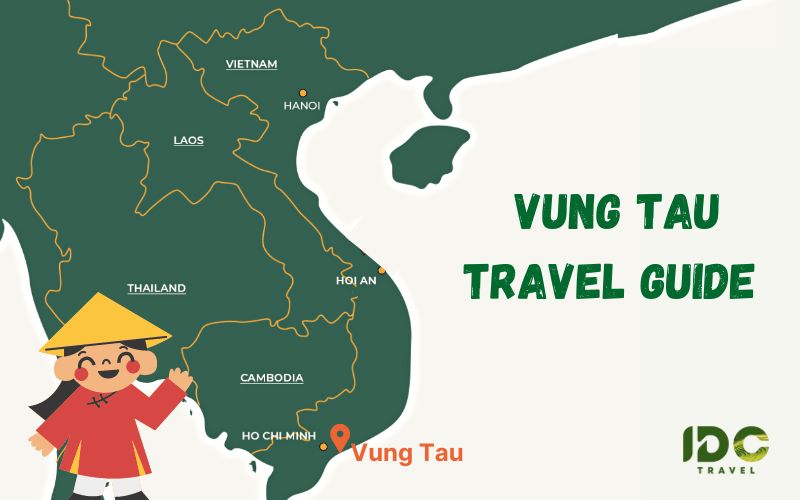
Vung Tau Location -IDC Travel Guide
Vung Tau is not a crowded and busy province, covering an area of 1,989 square kilometers with mountains and a delta and a population of just over one million people, which is one of the true benefits when it comes to nature tourism. In the past, this province created glorious heroic pages with some well-known historical sites such as the Cau Da vestige, the Phao Co battlefield, the Nui Dinh revolutionary base, the Long Phuoc tunnel, the Con Dao prison system, and so on.
Furthermore, Vung Tau is endowed with stunning beaches, poetic mountains surrounding the city, and a cool climate all year. The extremely beautiful shores, the old famous lighthouse, the statue of Jesus Christ with outstretched arms, and numerous delicious foods, among other things, impress both domestic and international visitors. During your visit to Southern Vietnam, you can combine Vung Tau with Ho Chi Minh City tours and Mekong day tours.
Vung Tau Weather and Best Time to Visit
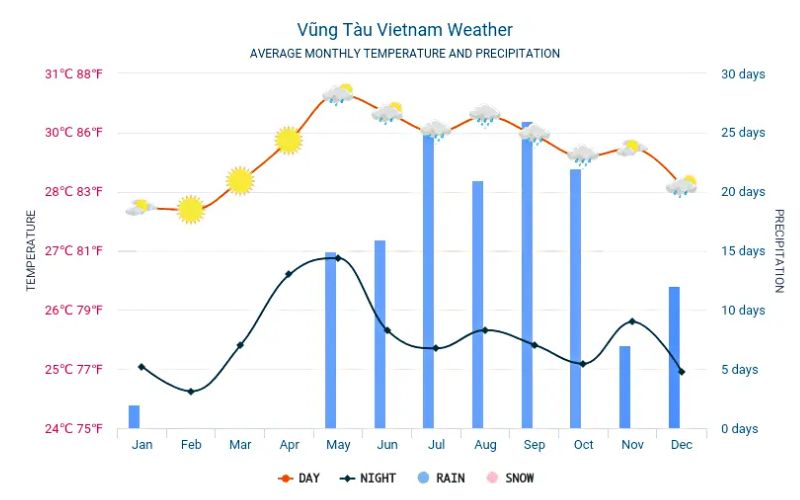
Vung Tau Weather and Best Time to Visit
Just a few hours drive from the city center, Vung Tau enjoys a fresh, warm and breezy coastal climate all year round. Average temperatures range from 25°C to 30°C, with cool, pleasant sea breezes compared to the city centre.
- The dry season lasts from November to April, when the skies are clear, humidity is low and seas are calm, with long stretches of beaches and clear waters ideal for swimming, beach walks and coastal sightseeing. This is also the time when many tourists and locals come here for weekend getaways, so be prepared for a lively atmosphere during the holidays.
- From May to October, the rainy season brings short but heavy afternoon showers, cooling the air and giving the beaches a more relaxed feel. Although you will still be able to swim and sightsee, you should check the weather before you go, especially during the peak monsoon season in August and September.
The best time to visit Vung Tau is from December to March, when temperatures are not too high and the sun is shining, the evenings are pleasantly cool and you can enjoy Vung Tau’s beaches, seafood restaurants and the most stunning views – all in the vibrant new coastal area of Ho Chi Minh City.
Getting to Vung Tau
By Road
From the center of Ho Chi Minh City, Vung Tau is about 95 km away. The trip takes about 2–2.5 hours via the Long Thanh – Dau Giay Expressway, providing a smooth and comfortable ride. You can catch bus route 19 from the Central Bus Station (opposite Ben Thanh Market) or choose reputable bus companies such as Hoa Mai, Phuong Trang, etc.
If you want a more private trip, choose to rent a private car with or without a driver. Although the price will be higher than other means of transport, it is very convenient if you have a busy schedule or are traveling in a large group.
By ferry
Another option is to take a high-speed ferry from Bach Dang Wharf in the center of Ho Chi Minh City. The journey down the Saigon River to the sea takes about 90 minutes, providing a refreshing start to your coastal tour. The modern ferries are air-conditioned, comfortable and run multiple trips per day. Most visitors will prefer the ferry as they can see the maritime commercial areas as the boat moves along the Saigon River towards the sea.
By motorbike
Adventurous travelers often take a motorbike to Vung Tau, enjoying the wide coastal roads and countryside views. The trip takes around 3 hours, depending on traffic and stops along the way. This option allows you to explore the small towns, cafes and hidden beaches along the way.
Getting around Vung Tau
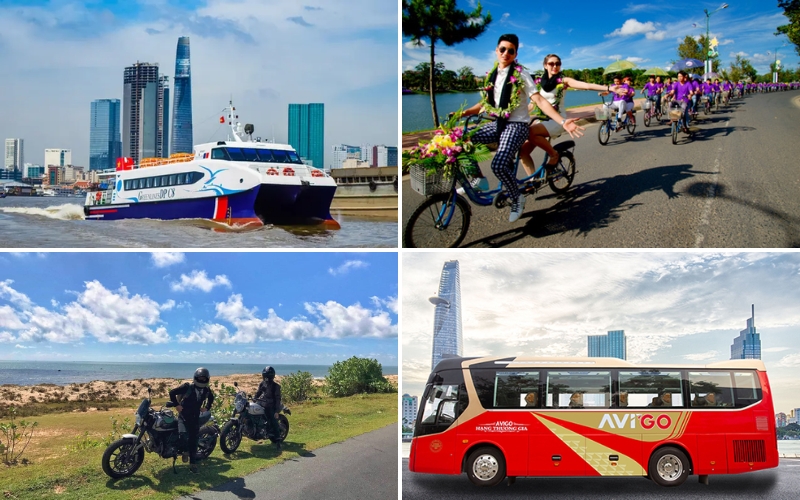
Some of the main transportations in Vung Tau
Taxis or ride-hailing apps
Traditional taxis are popular, but we recommend using ride-hailing apps like Grab or Be for their transparent pricing and ease of booking. They are a comfortable option for short trips between beaches, attractions and restaurants. However, fares will be 30% higher than in HCMC, especially along the beaches.
By motorbikes
Renting a motorbike is the most flexible way to explore. You can cruise along the winding coastal roads, visit both Front and Back Beaches, and even head to the quieter Long Hai or Ho Tram beaches. Motorbikes are very affordable and widely available in the city centre. If you are not confident driving on the streets of Vietnam, you can take a motorbike taxi. All are friendly, hospitable and professional.
By bike
To save time, bikes are perfect for short trips between attractions, especially in the cool mornings or late afternoons. Some hotels offer free or cheap bike rentals, especially tandem bikes, which are popular in Vung Tau. Cycling in groups of at least four people along the winding, green roads along the coast is a common sight in Vung Tau.
By foot
If you’re staying near the beach, walking is a fun way to explore. Vung Tau isn’t a big city, and the weather, even in summer, is cool and breezy; you won’t have to worry about sunburn like you would in the North. Many of Vung Tau’s highlights—like the statue of Jesus, the lighthouse, and the beachside cafes—are within walking distance.
By local bus
Although less popular with tourists, local buses connect Vung Tau to nearby towns and beaches. This is the cheapest option but requires a little patience and basic Vietnamese to navigate.
Where to Stay in Vung Tau
While Vung Tau isn’t a typical tourist destination, it’s a great place for residents or anyone staying in Saigon for an extended period of time to get away from the city. The air is cleaner, the pace is a little slower. There are many homestays, hotels, and resorts in Vung Tau for you to choose from.
- Pullman Vung Tau
Address: 15 Thi Sach Street, Thang Tam Ward
- Seaside Resort Vung Tau
Address: 18 Tran Phu Street, Ward 1
- Malibu Hotel
Address: 263 Le Hong Phong Street, Thang Tam Ward
- Lan Rung Resort & Spa
Address: 3-6 Ha Long Street, Ward 2
- Phoenix Hotel Vung Tau
Address: 249 Le Hong Phong Street, Ward 8
What to See in Vung Tau
Vung Tau is not a large city, but it is absolutely beautiful and charming. Fantastic beaches with a beautiful blue sky and clear seawater are a big draw for both locals and tourists. Let’s explore the city to find some interesting spots.
Front Beach (Bai Truoc)
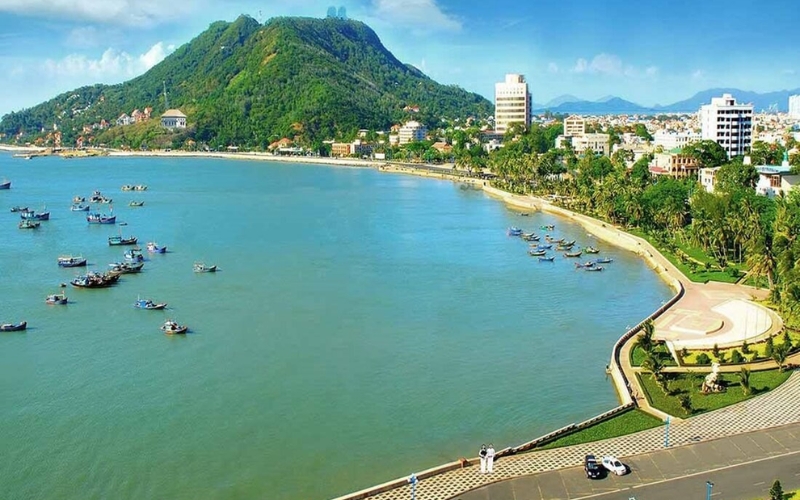
Front Beach
This beach is located in the heart of Vung Tau and stretches one kilometer in length between Big Mountain and Small Mount. The main activity here is the fishermen gathering, which began at 5.30 a.m. There can be up to twenty small fishing boats on the beach at any given time, unloading catch, re-stacking nets, taking on supplies, and so on. Preparing a camera, bringing it to the front beach, and having a delicious breakfast in one of the many coffee shops, breakfast shops, and restaurants there, you will then be free to take as many pictures as you want to satisfy your creativity.
Back Beach (Bai Sau)

Back Beach of Vung Tau
Back Beach, Vung Tau’s main tourist attraction, is one of Vietnam’s largest and most beautiful beaches. It has over 10 kilometers of fine sand beach and is always crowded with tourists on weekends and holidays. The white sand dunes, calm sea surface, and vast casuarina forest immediately entice visitors. All the stress and burdens of city life will be dispelled by coming here, taking a deep breath, feeling the tiny vibration on your skin, and listening to the harmonious songs sung by the Casuarinas foliages. There are numerous leisure and relaxation centers, including Paradis, an upgraded swimming and relaxation area, and a hotel system.
Pineapple Beach (Bai Dua)
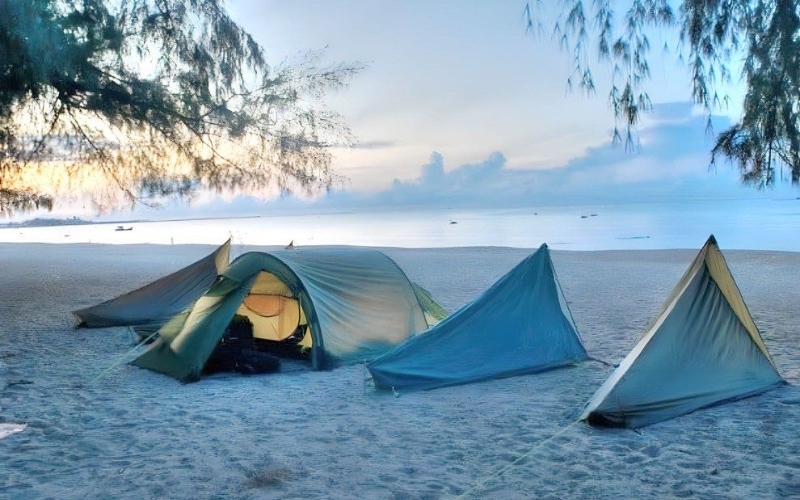
Pineapple Beach
This is a small beach near Small Mountain off Ha Long Street. The name dates back a long time. Locals claimed that there used to be a variety of pineapple trees on the beach, so they named it Pineapple. Tourists are drawn to the cool environment created by stunning rock mountains that run from land to sea, forming poetic and beautiful small beaches and a shady row of trees. There are also numerous hotels and villas on the hill with reasonable rental fees.
Mulberry Beach (Bai Dau)
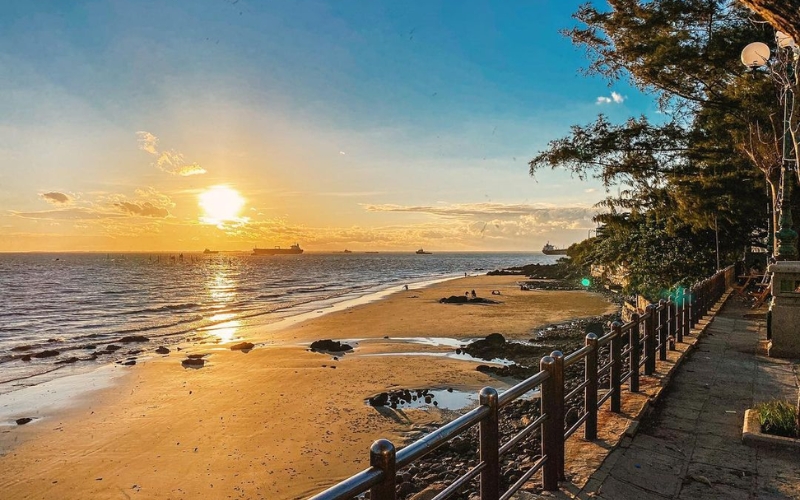
Bai Dau
This is yet another small beach at the base of Big Mountain. With the small waves, there is some wind. The number of visitors who come here to swim in the sea is not large. As a result, it is an ideal location for those who appreciate peace, cleanliness, and quiet beauty.
Vung Tau Lighthouse
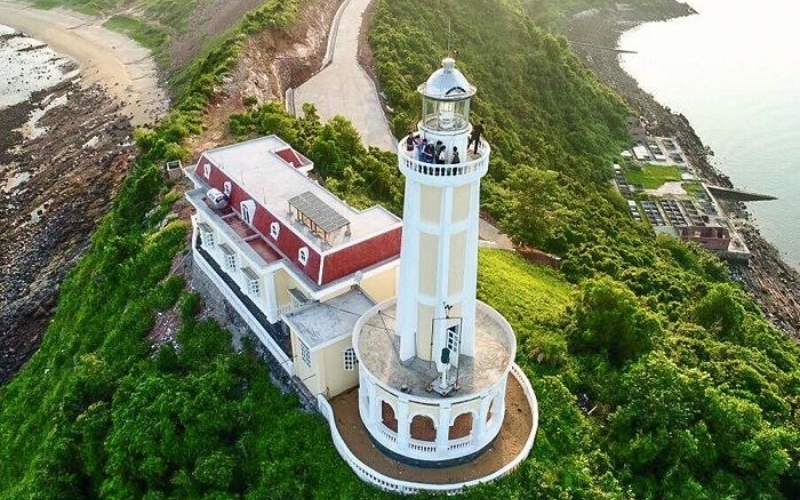
Vung Tau Lighthouse
This was constructed on the summit of Small Mountain in 1907. The house is 3m in diameter and 18m in height, and it has been relocated to a higher peak. With available telescopes, the lighthouse can project light as far as 35 sea miles (64.75km) and follow and direct ships on the sea. The top of the lighthouse provides a panoramic view of Vung Tau. There is no admission fee, but you must pay about VND 5,000 dong per visit.
Statue of Jesus Christ
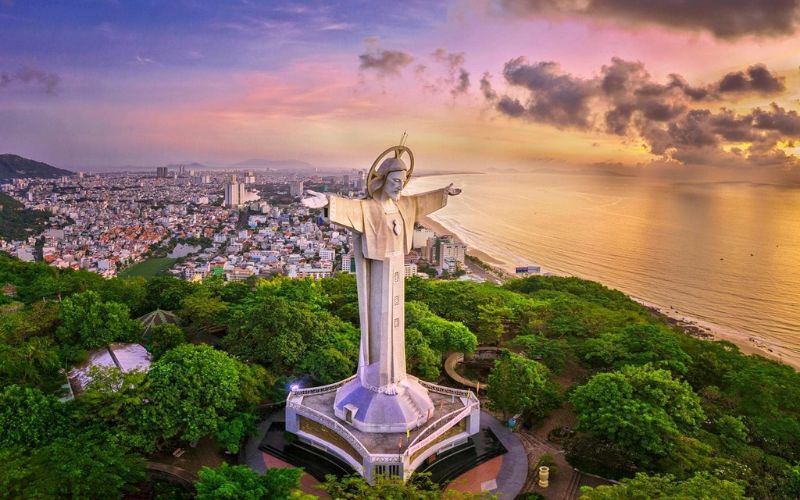
Statue of Jesus Christ
The Jesus statue, perched atop Small Mountain with outstretched arms, gazes across the East Sea. It was started in 1974 and finished 20 years later. The statue is 32 meters long and 170 meters above sea level. The interior of the statue is hollow, with a spiral staircase of 129 steps leading to the statue’s neck, shoulders, and wrists, where four or five people can stand and enjoy a magnificent view of the surrounding landscape. Each hand is 2.2m wide, the middle finger is 1.1m long, and each foot is 1.1m wide. This statue is similar to the one in the Brazilian city of Rio de Janeiro.
The White Palace (Bach Dinh)

Bach Dinh
The Palace was built by the French (1898 – 1916) as a summer palace for French Governor General Paul Doumer and stands 50 meters above sea level along Tran Phu Street. Bach Dinh has a Roman architectural structure with three floors and a height of 19 meters. A long row of 19 cannons has been preserved here until now.
What to Eat in Vung Tau
Not only does Vung Tau have a beautiful sandy coastline, but it also has delicious food, making it an absolutely perfect destination for you to stop by and experience a perfect tour of Southern Vietnam.
Banh Khot Vung Tau (Vietnamese mini pancake)
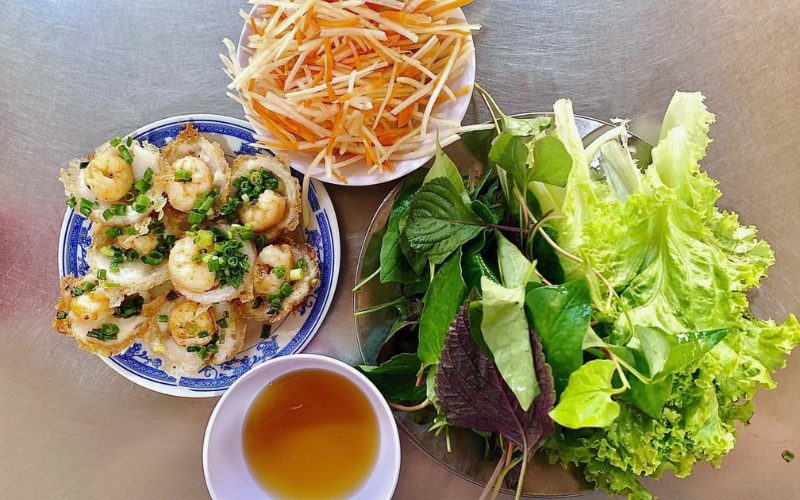
Banh Khot
Ely to eat Banh Khot. These small round Khot cakes have a white surface, a red layer made of mixed flour and curry powder, and are filled with seafood such as shrimp and squid before being topped with green onion and shrimp powder.
Goi Ca Mai ( Mai fish salad)

Mai fish salad
Goi ca mai is regarded as one of the most appealing dishes in Vung Tau. Mai fish is similar to anchovies in appearance and flavor and is frequently used in salads. Locals believe that the best goi ca mai is made by selecting the freshest live Mai fish – the fresher the fish, the more delicious the salad.
Sawfish hotpot
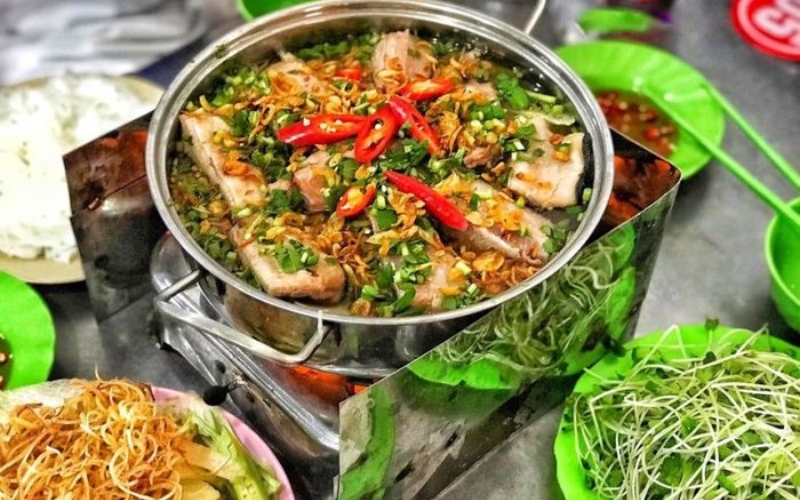
Stingray Hot Pot
Sawfish hot pot is a delicious folk food in Vung Tau with a distinct flavor and ingredient. Sawfish is a boneless fish with only soft cartilage that will be chopped into medium pieces and stewed on low heat to create a sweet broth before being seasoned. Take a bite of everything together to get the most delicious bite ever.
Chao Hau (Oyster Porridge)
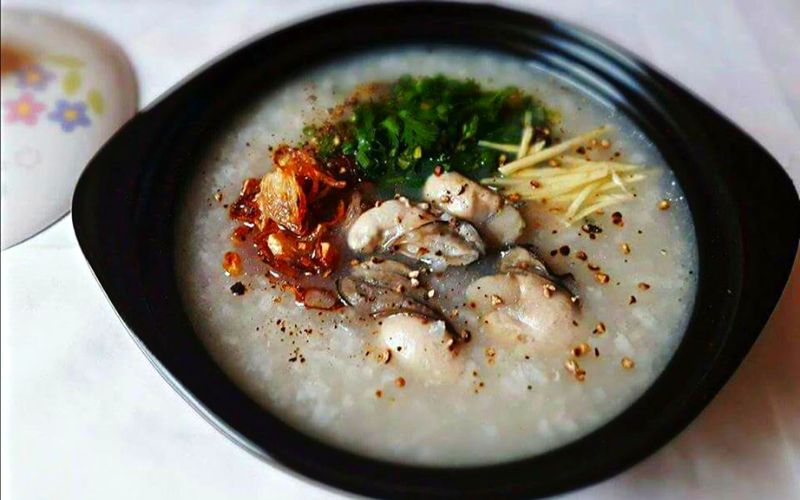
Oyster porridge is a popular dish in Vung Tau. When every shop serves it, it’s difficult to find a bowl of delicious dish. The food appears to be simple to prepare; however, making a delectable oyster porridge is difficult. To balance the taste of the porridge, use a reasonable amount of seasoning.
Banh Canh
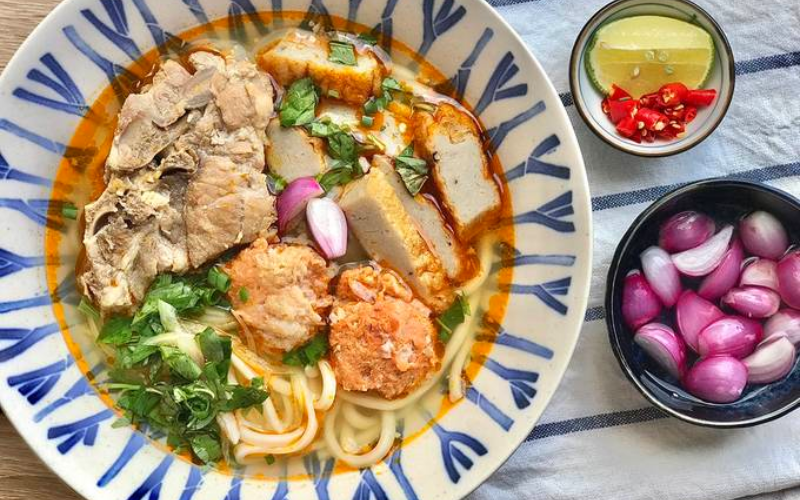
Banh Canh (Thick Noodle Soup)
Tourists frequently stop in Ba Ria on their way from Saigon to Vung Tau for snacks and a bowl of banh canh Long Huong. There’s no need to be fussy with many ingredients because this long-standing vendor has won over many foodies with its simplicity and purity. Banh Canh is a Vietnamese dish made of rice and tapioca flour, light broth, tender and greasy pig legs, and pork. After a long ride, all you need is a bowl of banh canh and sugarcane juice to revive you and allow you to continue your journey with many other activities in Vung Tau.
Fresh Seafood
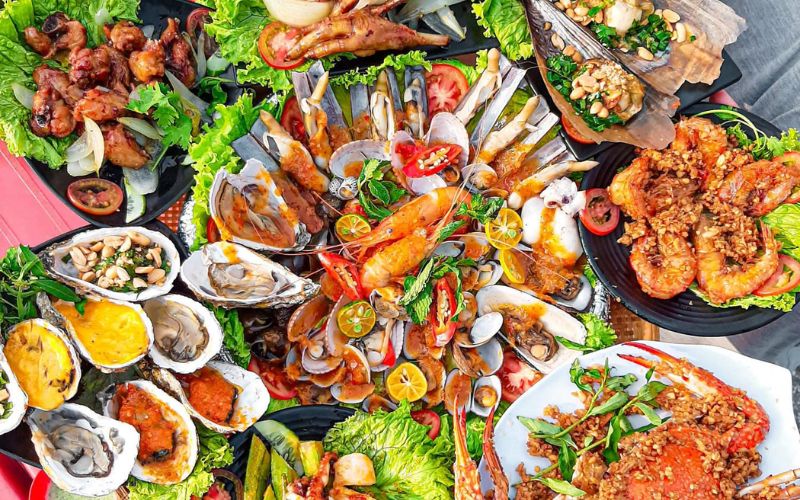
Various types of seafood
Never leave Vung Tau without sampling the fresh seafood on offer. Every day, crabs, snails, shrimp, blood clams, amberjack fish, and other sea creatures are brought directly from the sea.
We hope the information provided above is useful to you. Please contact us for more information, and start planning your adventure right away!